Filling In for Lawngrasses
Hardly any direct sunlight hits the 11 acres of our rural Collin County landscape. That’s why when people ask me what kind of grass they can grow in the shade I feel like I can speak with authority.
We bought this wooded creekside property in 1971. The trees weren’t nearly as tall then, and I was actually able to get bermudagrass to grow here and there for a while.
But in the ensuing half-century things have changed dramatically, and I’ve had to adapt to full shade. I’ve learned a lot, and I thought this might be a good time to share some of those lessons.
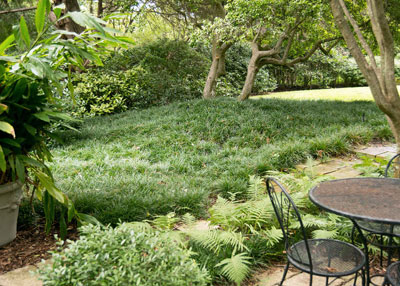
Things that I’ve learned…
• All of our lawngrasses must have sun. Some grasses (bermuda and buffalograss) require more (6 to 8 hours of hot, direct sunlight). Some (St. Augustine, and in Northwest Texas, fescue) can survive with as little as 5 to 6 hours of direct sunlight daily. But, they must have sun! Non-negotiable!
• There is absolutely no lawngrass, regardless of claims you may see in print or on TV, that will grow and spread in total shade. Don’t get hoodwinked into wasting your money on gimmicky grasses.
• If you have tried new St. Augustine sod, and if it has faded within just a few months, leaving thin, rubbery rectangles of soil that came with the sod, there isn’t enough light. That’s your sign. Relax, and quit flailing. It’s time to take a different approach.
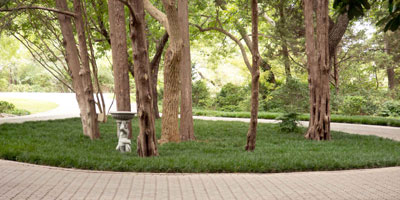
• You can try removing one or two low branches from your shade trees. That might let enough light in to keep the grass growing, but don’t disfigure the trees in the process. Odds are that the trimming won’t give enough help, and the trees are valuable landscaping assets that you don’t want to mangle.
How we handled shade in the Sperry landscape…
• Facing those same odds, I learned many years ago that I would have to switch over to a permanent groundcover. I used Persian ivy for a while, and I still have some Asian jasmine and purple wintercreeper euonymus beds. But, each of those groundcovers produces vining stems, and our pecan leaves were always getting hung up on those stems, making fall cleanup difficult and time-consuming.
• Mondograss quickly became my groundcover of choice. It is not a true grass. It’s actually in the lily family, hence one of its common names: lilyturf. Perhaps you know it as monkeygrass, and its scientific name is Ophiopogon japonicus.
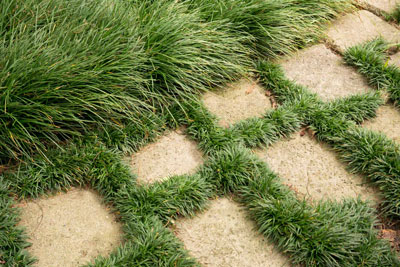
• Mondograss grows to 6 or 7 inches tall. It has no runners, so it’s easily cleaned. This is not dwarf mondograss. I like that little plant, too, but it’s way too slow growing and far too expensive for me to use in big spaces. And, this is not liriope. That’s the larger cousin – the plant that produces purple (sometimes white) floral spikes during the summer. Mondograss flowers are small and inconspicuous.
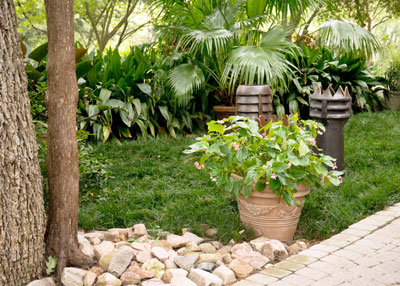
• You can walk through mondograss occasionally to do maintenance or to retrieve toys, but it is not a turfgrass. You can mow it in late winter to remove any browned leaf tips that might have resulted from extreme cold. I’ve done that once in 43 years. You would set the mower as high as it would go.
• Mondograss grows in full shade. It tolerates a certain amount of sun, but it’s not suited to afternoon sun in a hot Texas summer. It will bleach to a pale green, even yellow, then brown. This plant is for shade.
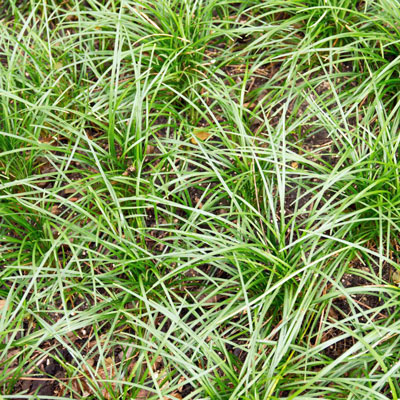
• You can plant mondograss at any time of the year. Fall is especially good. Your goal will be to set out fist-sized clumps on 8- or 10-inch centers. At that spacing, their leaves will touch, and the bed will look solid when viewed from the side. As a side note, you can actually dig your own mondograss if you have established beds. That’s how I’ve started my own plants for the past 35 years.
• The more attentive you are to watering and feeding your new mondograss groundcover bed, the more quickly it will fill in. Apply an all-nitrogen fertilizer, one pound per 100 square feet, two or three weeks after planting. Repeat in March, May and September each year. Water deeply immediately after feeding. It should cover within 18 months after planting.
• And finally, I finish off all my shade beds with shrubs that are equally well suited to shady surroundings. I use 25 or 30 types of hollies of all shapes and sizes, also oakleaf hydrangeas, viburnums, nandinas, aucubas (total shade only) and Japanese maples. I’ve used aspidistra, but it’s winter-tender for anyone in North Texas, so it requires special care and covering each winter. All of which is to say: shade is no curse. It’s just a new opportunity. But it all depends on the green carpet of mondograss to tie it together.
